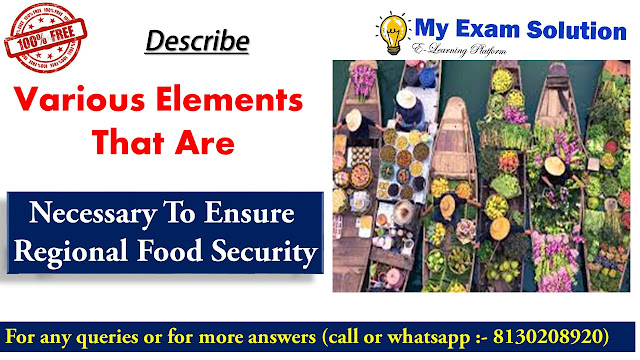Describe various elements that are necessary to ensure Regional Food Security
Regional food security refers to the availability and
accessibility of adequate, safe, and nutritious food in a specific geographic
area. To ensure regional food security, several elements are necessary,
including:
- Agricultural production: A strong and sustainable agricultural sector is crucial for regional food security. This includes improving crop yields, promoting diversification of crops, and increasing resilience to climate change and other environmental challenges.
- Infrastructure and transportation: Adequate transportation and storage infrastructure is necessary to move food from where it is produced to where it is needed. This includes roads, ports, and storage facilities that are designed to reduce waste and spoilage.
- Market systems: Effective market systems are necessary to connect food producers with consumers, and to ensure that food is distributed equitably and efficiently.
- Food safety and quality: Food safety and quality are essential for ensuring that food is safe and nutritious for consumption. This includes regulations and systems that ensure food is free from contaminants and that food labeling is accurate and transparent.
- Social protection: Social protection programs and safety nets are necessary to ensure that vulnerable populations, such as women, children, and the elderly, have access to adequate and nutritious food, especially during times of food insecurity.
- Nutrition education: Nutrition education and awareness programs are necessary to promote healthy eating habits and to reduce malnutrition, particularly in children.
- Environmental sustainability: Environmental sustainability is important to ensure that food production is sustainable and that the natural resources needed to produce food are conserved for future generations.
Ensuring regional food security requires a comprehensive and
integrated approach that takes into account these various elements and the
specific needs and context of the region.
How do you ensure regional food security
Ensuring regional food security requires a multi-faceted
approach that addresses the various factors that contribute to food
availability, accessibility, and quality in a specific geographic area. Some
key strategies to ensure regional food security include:
Strengthening agricultural production: This includes
improving crop yields, promoting diversification of crops, and increasing
resilience to climate change and other environmental challenges. It also
involves investing in research and development to develop new and improved
agricultural technologies.
Improving infrastructure and transportation: Adequate
transportation and storage infrastructure is necessary to move food from where
it is produced to where it is needed. This includes roads, ports, and storage
facilities that are designed to reduce waste and spoilage.
Developing effective market systems: Effective market systems
are necessary to connect food producers with consumers, and to ensure that food
is distributed equitably and efficiently. This may include strengthening local
food markets and promoting trade and investment in the agricultural sector.
Ensuring food safety and quality: Food safety and quality are
essential for ensuring that food is safe and nutritious for consumption. This
includes regulations and systems that ensure food is free from contaminants and
that food labeling is accurate and transparent.
Providing social protection: Social protection programs and
safety nets are necessary to ensure that vulnerable populations, such as women,
children, and the elderly, have access to adequate and nutritious food,
especially during times of food insecurity.
Promoting nutrition education: Nutrition education and
awareness programs are necessary to promote healthy eating habits and to reduce
malnutrition, particularly in children.
Ensuring environmental sustainability: Environmental
sustainability is important to ensure that food production is sustainable and
that the natural resources needed to produce food are conserved for future
generations.
It's important to note that a comprehensive and integrated
approach is necessary to ensure regional food security, taking into account the
specific needs and context of the region, and involving all stakeholders,
including governments, communities, farmers, and the private sector.
What are the six elements of the food safety plan
The six elements of a food safety plan are:
- Hazard Analysis: Identification and assessment of potential physical, chemical, and biological hazards in food.
- Preventive Controls: Implementation of measures to prevent or reduce the likelihood of hazards identified in the hazard analysis.
- Monitoring Procedures: Ongoing monitoring to ensure that preventive controls are functioning as intended.
- Corrective Actions: Procedures to take if preventive controls are found to be inadequate or if a hazard occurs.
- Verification: Evaluation of the food safety plan to ensure that it is working effectively.
- Record Keeping: Documentation of the food safety plan, including hazard analysis, preventive controls, monitoring, corrective actions, and verification.
What is regional security order
A Regional Security Order (RSO) is a security measure
implemented by a government or security agency to maintain safety and security
in a particular region. The scope and nature of RSOs can vary widely, depending
on the specific security concerns and regional circumstances.
Examples of RSOs may include restrictions on travel or
movement in certain areas, limitations on the use of certain types of weapons
or equipment, or enhanced security measures for critical infrastructure and
facilities. The purpose of an RSO is to prevent or mitigate security threats
and ensure the safety of people and property in the affected region.
It's important to note that RSOs are not a one-size-fits-all
solution and may be tailored to specific security threats and regional
circumstances. The implementation of an RSO must also balance the need for
security with respect for human rights and civil liberties.
ALSO READ:-
- The trends of agricultural growth in India since Independence
- Why is Sarva Shiksha Abhiyan (SSA)
- What is the role of Science and Technology in the process of Rural Development
Whatsapp :- 8130208920
Youtube :- Myexamsolution







0 comments:
Note: Only a member of this blog may post a comment.